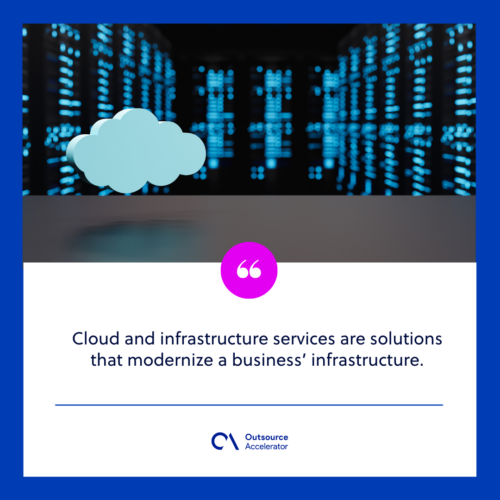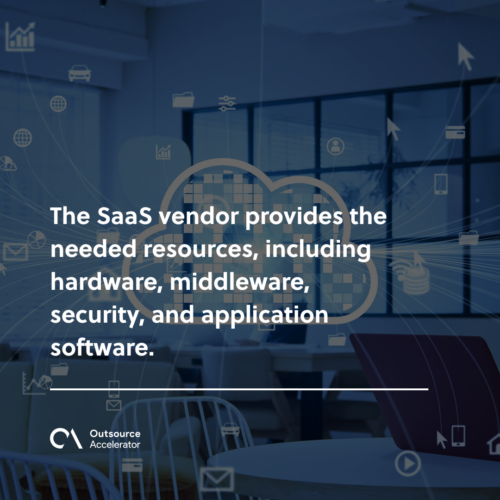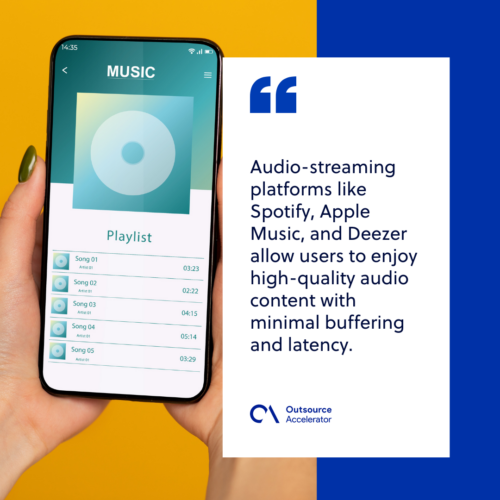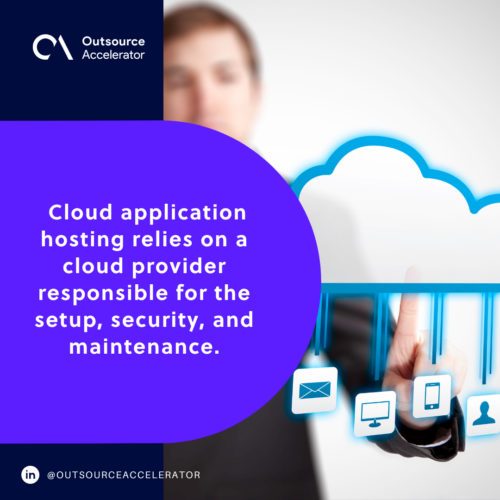Cloud and infrastructure services to improve your business intelligence

The information technology (IT) industry has evolved in ways you cannot imagine. As new technologies emerge, they shape the future of IT and business everywhere.
For instance, businesses across the globe have been moving to the cloud. This is not the white cotton candies in the sky. The cloud has fueled start-up companies, medium-scale businesses, and large enterprises in recent years.
Before the cloud, people buy expensive hardware and physical data storage devices. However, these traditional resources need to catch up with the changes.
This is why most businesses need to modernize their IT infrastructure. They can do this by exploring cloud and infrastructure services.
Today, you can quickly access technologies through the cloud and develop anything you can imagine.
What is cloud and infrastructure service?
Cloud and infrastructure services are solutions that modernize a business’ infrastructure. These services position the company to take the future. They reduce operational costs and orchestrate the competitive value of their digital transformation.
Moreover, cloud and infrastructure services provide access to flexible computing resources, networking capabilities, and storage without capital-intensive physical hardware.

Types of cloud computing services
The cloud computing service model comes in three categories:
Infrastructure as a service (IaaS)
Infrastructure as a service (IaaS) is a cloud computing service where you can rent IT infrastructure, including databases, servers, storage, and networking resources.
Here’s a scenario to understand this model better:
You want to build your dream house. Before building a house, you must purchase land, look for workers, and buy construction materials. Now you realize that the whole house building is time-consuming and expensive.
Thus, you seek another option to solve this problem by renting the land and construction materials from a third-party provider. This solution is similar to how IaaS works in cloud computing. You pay for the resources you use.
Forward-looking businesses have favored IaaS to innovate and stay ahead of the competition. Since maintaining data centers on-premises is difficult and expensive, some companies have moved to the cloud.
In the IaaS model, you don’t need to worry about buying, setting up, and maintaining all the hardware.
Some third-party providers, like Google Cloud Platform and Amazon Web Services, offer the resources to run your services and applications. You can access the virtual infrastructure and not worry about upgrading and maintaining them physically.
Platform as a service (PaaS)
Platform as a service (PaaS) is another type of cloud computing service to build and run applications.
It allows businesses to test, build, and deploy applications. Companies can “rent” or outsource infrastructures from third-party providers, including servers, middleware, storage systems, and network tools. Databases and support crew are also available.
PaaS is for programmers and developers. They can focus on writing codes and building the application while the PaaS handles server maintenance updates, security, and scaling.
However, if the PaaS platform experiences a service outage, businesses cannot access the “rented” resources. This disruption can negatively impact the business’ revenue and productivity.
One advantage of PaaS is its ability to create and deploy software applications faster.
However, remember that PaaS only offers the tools; the company is responsible for maintaining and managing the application’s workload. This allows businesses to control their applications’ features and ensure data security.
Some examples of PaaS are DigitalOcean, AWS Elastic Beanstalk, Quickbase, and Boomi.
Software as a Service (SaaS)
Did you know businesses with over 1,000 employees use over 150 SaaS applications? This has become the “new normal” in today’s business environment because they want to remove the time-consuming and painful installations in the picture.
Customers can access an application via their preferred web browsers in the SaaS business model. They don’t have to install or update the application on their computer or update it by themselves.
The SaaS vendor provides the needed resources, including hardware, middleware, security, and application software. Businesses would pay for what they need, reducing the upfront costs.
There are several areas where businesses can implement SaaS tools. It can be for team collaboration, content management, project management, customer support, IT security, and automated billing systems.
For example, Zoom is a cloud-based video and audio-conferencing application. It allows individuals and businesses to communicate remotely using a single platform and multiple devices.
They pay subscription fees for updates and software maintenance. Other well-known SaaS tools are Microsoft Office suite, Slack, Microsoft Teams, and Salesforce.

3 features of cloud and infrastructure services
What features should businesses expect from all cloud and infrastructure service providers?
Security
Many businesses doubt moving to the cloud because of security concerns. No one can blame them, though. Think about it: it is not difficult for cyberattackers to do the same thing if you can access your data remotely.
However, security is one of the best features of cloud and infrastructure services. The multiple levels of security safeguard the resources and computing environment from internal and external threats.
Remember that security is the responsibility of both the cloud provider and the customer. It is important to do your due diligence.
Scalability
A scalable infrastructure means businesses can scale their use of IT resources up or down based on demand.
In the past, scaling an on-premise physical infrastructure could take months. With a third-party cloud provider, the resources are already in place.
Scalability is possible because of virtualization. Unlike physical machines, IT administrators can move virtual machines to a different server or host them on multiple servers simultaneously.
This advantage helps businesses stay on top of the competition. When the workload increases, a scalable cloud solution can enable companies to increase storage and performance with little to no disruption.
Economical
Investing in cloud and infrastructure services is economical in the long run. Compared to on-premise infrastructure, you would only pay for the resources and infrastructure you used. It reduces the upfront capital and operational expense from on-premise infrastructure.
6 real-world examples of cloud and infrastructure services
Check out these six real-world examples and applications of cloud and infrastructure services:
Video-streaming platforms
In earlier years, broadcasters streamed their video by setting up on-premise infrastructures that were costly and complex to maintain.
After the black-and-white silent films, people worldwide are fortunate to experience virtual reality movies today. You have the power of the cloud to thank for that.
Today, broadcasting companies are moving to cloud video platforms for a more straightforward hosting and video streaming solution.
These cloud video platforms help businesses get their message to the audience without the heavy investments and complexity of installing physical servers and hardware.
How does the cloud-based streaming platform work? When broadcasters upload video content to a network of cloud servers, it undergoes video transcoding and encoding.
This process creates various renditions and formats of the video file efficiently. It allows viewers to access and watch the video on their preferred device anywhere.
Investing in a cloud-based video-streaming platform is a smart move for businesses. It eliminates the hassle of an on-premise setup while getting everything the brand needs to stream videos at the highest quality.
File-hosting
The explosion of cloud computing has revolutionized online file storage and syncing services. It has changed the way people share, access, and store files.
Working on a single document with different people in the past could have been smoother. It was a huge hassle to keep track of the changes made.
Fortunately, file hosting or cloud storage exists today. It is an online platform where you can store and host your files, including videos, photos, documents, and other file types.
You can also share these files with other businesses or people. File-hosting platforms allow you to have backup copies of your files and sync them across multiple devices.
Dropbox, Microsoft OneDrive, and Google Drive are well-known platforms offering file-hosting services. They provide free file hosting and allow you to upgrade to a bigger storage size for a fee.
Subscribing to these services means that they will back up your data on multiple servers. In case of a server glitch, you won’t have any problem accessing these stored files.
Music-streaming platform
Gone are the days of buying CD albums and vinyl and waiting for MTV. Although they still exist, you can now listen to your favorite music and artist via a music-streaming platform.
This new opportunity has opened the doors for independent artists and lets people discover new music.
Streaming starts by transmitting small chunks of audio content through a network connection. Part of the streaming protocol is to send small data packets to the server. The streaming server receives the chunks of data and forwards them to the user’s device.
Once received, the device buffers the data packets. It allows the user to listen to the audio without interruption. The server downloads the next set of data packets for continuous streaming as users play the music continuously.
Audio-streaming platforms like Spotify, Apple Music, and Deezer allow users to enjoy high-quality audio content with minimal buffering and latency.
Moreover, they can create a playlist, save and check recommended songs, and listen offline. While there are ad-free options, most cloud-based music-streaming platforms charge premium fees to maximize the application’s features.

Chatbots
If you are looking for a way to improve your customer service, chatbots might be the solution you need to maximize.
A chatbot is a software application designed to interact like a human. It provides a conversational interface to any application using text and voice.
If you are unfamiliar with the concept, think of Siri and Alexa. These two names are cloud computing and chatbot technologies products, which have transformed customer service over the past years.
There are several uses for chatbots. You can use them to generate leads, gather feedback, and personalize user experience.
However, the speed makes chatbots a valuable customer service arsenal for businesses. Tidio reported that 62% of customers would rather talk to a chatbot than wait for a customer service representative to take their call.
Chatbots use Artificial Intelligence (AI) to understand customer inquiries and provide answers accurately. The fast response time and efficient automation solutions enable the customer service representative to satisfy the customer’s appetite for instant gratification.
Networking
Cloud networking allows businesses to deliver a secure global network through a centralized platform. It can either be cloud-enabled or cloud-based.
In cloud-enabled networking, all or some resources are in the cloud, but the network is on-premise. This means the core network infrastructure, like packet forwarding and routing, are in-house, and network management, maintenance, and security are through the cloud.
Meanwhile, the network management and entire physical hardware are in the cloud for cloud-based networking. Virtual private networks (VPNs), firewalls, and bandwidth are examples of cloud networking services.
Application hosting
Businesses–no matter what size–have turned to hosted applications. Application hosting gives you an avenue where you can host your business applications and keep them running.
It is one way to outsource IT infrastructure while eliminating the need to buy and maintain localized resources. Traditional application hosting involves a single server to host workloads.
Meanwhile, cloud application hosting relies on a cloud provider responsible for the setup, security, and maintenance. This allows you to focus on core matters and harness the full potential of your IT environment.
Some common examples of hosted applications are WordPress, Zendesk, and Salesforce.

Unlock your business’ potential with cloud and infrastructure services
Thanks to the cloud and infrastructure services, even small businesses have the opportunity for growth at an affordable cost. Moving to the cloud increases efficiency, simplifies administration, and reduces operational costs.
Using cloud and infrastructure services benefits both businesses and consumers. They strengthen the key areas in the business and improve customer engagement virtually.
Your business is only as strong as your IT infrastructure. It does not only connect people; it makes a huge difference in businesses’ productivity.







 Independent
Independent




